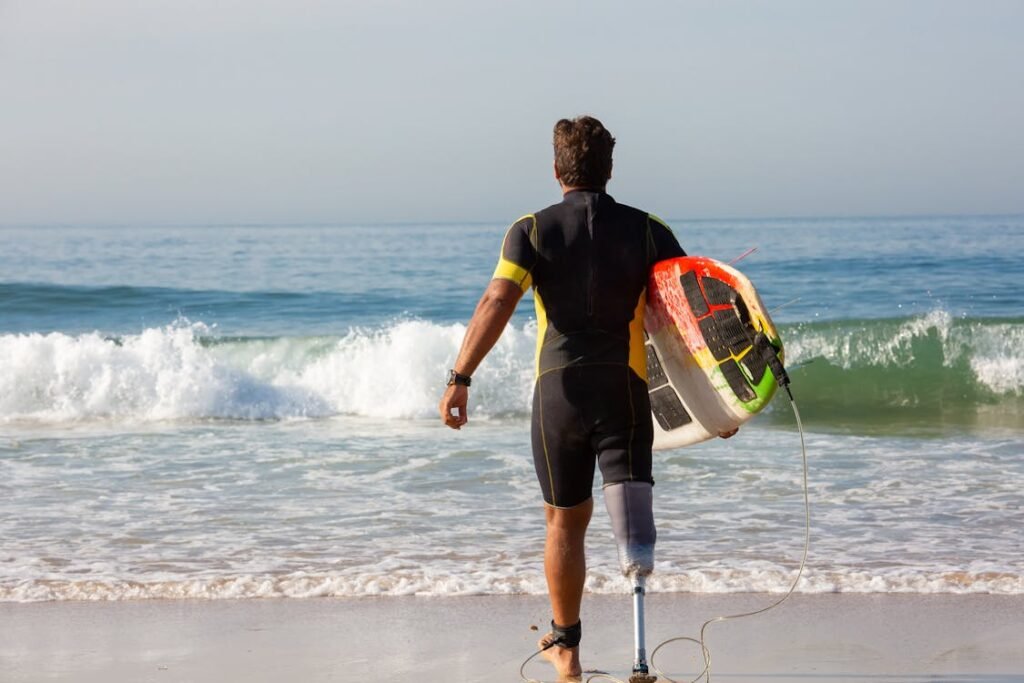After an amputation, the body undergoes major adjustments, and one of the biggest concerns is muscle loss. The muscles surrounding the residual limb, as well as those in other parts of the body, can weaken due to reduced activity, changes in movement patterns, and loss of direct function. Muscle loss not only affects strength but also impacts balance, prosthetic control, and overall mobility.
Preventing muscle loss requires a combination of proper nutrition, targeted exercises, and lifestyle changes that support muscle maintenance. Staying active, consuming the right nutrients, and engaging in rehabilitation exercises can help keep the body strong and functional.
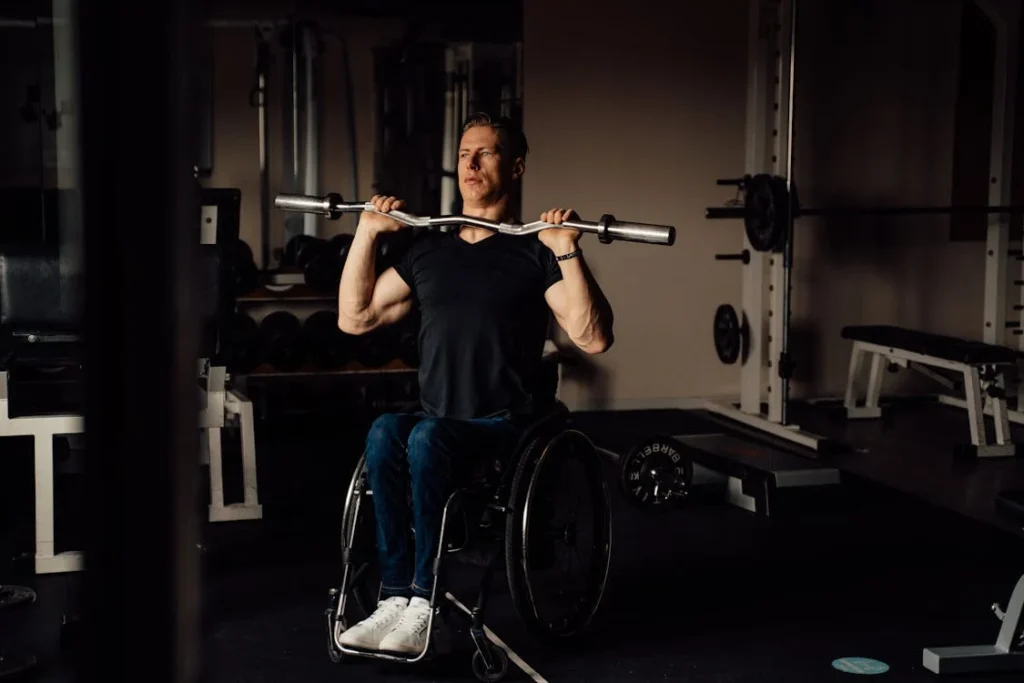
Why Muscle Loss Happens After Amputation
Muscle loss, also known as muscle atrophy, is a common issue for amputees, especially in the months following surgery. This happens when muscles are not used regularly, leading them to shrink in size and lose strength.
Several factors contribute to muscle loss after amputation, including reduced physical activity, changes in movement patterns, and metabolic shifts in the body. Understanding why muscle loss occurs is the first step toward preventing it and maintaining long-term strength.
Reduced Physical Activity and Limited Mobility
Immediately after an amputation, physical activity naturally decreases due to the healing process. Rest is necessary for recovery, but prolonged inactivity causes muscles to weaken.
When muscles are not used, the body starts breaking them down for energy, leading to gradual atrophy. The longer a person remains inactive, the harder it becomes to regain lost muscle mass.
For lower-limb amputees, the muscles in the remaining leg, hips, and lower back can weaken due to changes in walking patterns. Without targeted exercises, these muscles may struggle to support the prosthetic limb, leading to imbalances and difficulty with mobility.
Upper-limb amputees also experience muscle loss in the shoulder, chest, and back due to reduced use of the affected side.
Changes in Movement Patterns and Weight Distribution
After an amputation, the body must adapt to a new way of moving. The remaining muscles work harder to compensate for the missing limb, but without proper strengthening exercises, some muscles may weaken while others become overworked.
This imbalance can lead to poor posture, joint pain, and reduced endurance.
Lower-limb amputees often rely more on their intact leg, which can lead to muscle loss in the residual limb due to decreased usage.
Upper-limb amputees may find themselves using their non-amputated arm for most tasks, leading to further weakening of the muscles on the affected side. Over time, if these imbalances are not corrected, they can make prosthetic use more difficult and uncomfortable.
Metabolic Changes and Muscle Breakdown
The body’s metabolism changes after an amputation, which can contribute to muscle loss if not properly managed. When muscle mass decreases, the body burns fewer calories at rest, which can lead to weight gain if diet and activity levels are not adjusted.
Additionally, if protein intake is insufficient, the body may break down muscle tissue to meet its energy needs.
Stress hormones released after surgery, such as cortisol, can also contribute to muscle breakdown. Prolonged stress, whether physical or emotional, can interfere with muscle repair and regeneration.
Managing stress through proper nutrition, movement, and rest is essential to preventing unnecessary muscle loss.

Nutrition for Preventing Muscle Loss After Amputation
Diet plays a critical role in maintaining muscle mass, supporting tissue repair, and ensuring overall strength after an amputation. The body requires a steady supply of nutrients to rebuild muscle fibers, sustain energy levels, and prevent unnecessary muscle breakdown.
Without proper nutrition, even regular exercise may not be enough to preserve muscle strength. A balanced diet that includes the right combination of proteins, carbohydrates, healthy fats, and essential vitamins helps the body stay strong and functional.
The Role of Protein in Muscle Maintenance
Protein is the building block of muscle and is essential for preventing muscle loss. After an amputation, the body requires more protein than usual to repair tissues, strengthen the remaining muscles, and support prosthetic use.
Without enough protein, the body begins breaking down existing muscle tissue to meet its energy needs, leading to gradual muscle atrophy.
The best sources of protein come from lean meats, fish, eggs, dairy, legumes, nuts, and soy-based products. For those who have difficulty consuming enough protein through food alone, protein supplements such as whey, casein, or plant-based protein powders can help meet daily requirements.
Protein intake should be spread throughout the day, with every meal including a protein source to maximize muscle repair and recovery.
Collagen protein can also be beneficial, particularly for amputees who experience joint discomfort or skin irritation from prosthetic use. Collagen supports connective tissues, strengthens ligaments, and improves skin elasticity, reducing the risk of pressure sores and discomfort around the residual limb.
Carbohydrates for Sustained Energy and Muscle Fuel
Many people associate carbohydrates with weight gain, but they are essential for muscle preservation and energy production. Carbohydrates provide fuel for movement, making it easier to engage in physical therapy, prosthetic training, and daily activities.
Without enough carbohydrates, the body may turn to muscle tissue for energy, accelerating muscle loss.
Choosing complex carbohydrates over refined ones ensures that the body gets long-lasting energy without blood sugar spikes and crashes.
Whole grains, quinoa, sweet potatoes, oats, legumes, and vegetables provide fiber and essential nutrients that support digestion and steady energy levels.
Amputees who remain active should aim to include carbohydrates in their meals, particularly before and after exercise, to replenish muscle glycogen stores and support endurance.
Healthy Fats for Muscle Recovery and Inflammation Control
Fats are another important component of muscle maintenance. Omega-3 fatty acids, found in fish, flaxseeds, walnuts, and olive oil, help reduce inflammation, improve circulation, and support muscle repair.
Since inflammation can contribute to muscle breakdown, including these healthy fats in the diet can help protect muscle tissue while promoting better overall health.
Saturated fats and trans fats, often found in processed foods, fried items, and sugary snacks, should be limited as they contribute to inflammation and interfere with muscle recovery.
Instead, focusing on sources of unsaturated fats, such as avocados, nuts, and seeds, helps maintain proper hormone balance and keeps energy levels stable throughout the day.
Vitamins and Minerals Essential for Muscle Health
Certain vitamins and minerals play a key role in muscle function and preventing atrophy. Calcium and vitamin D are essential for bone strength, which directly affects mobility and prosthetic comfort.
Since the remaining limb takes on extra weight, maintaining strong bones is crucial for balance and endurance. Dairy products, fortified plant-based milks, leafy greens, and exposure to sunlight provide the necessary amounts of calcium and vitamin D.
Magnesium helps with muscle relaxation and prevents cramps, which can be common after amputation due to changes in movement and posture. It is found in nuts, seeds, whole grains, and dark leafy vegetables.
Potassium, another important mineral, helps regulate muscle contractions and prevents fatigue. Bananas, oranges, potatoes, and beans are excellent sources of potassium that help maintain muscle strength.
Iron is necessary for oxygen transport in the blood, ensuring that muscles receive the oxygen they need to function properly.
Amputees who experience fatigue or weakness may need to increase their intake of iron-rich foods such as lean meats, lentils, spinach, and fortified cereals. Vitamin C enhances iron absorption, so pairing iron-rich foods with citrus fruits or bell peppers can maximize their benefits.
Hydration and Its Role in Muscle Preservation
Staying hydrated is just as important as eating the right foods. Dehydration can lead to muscle cramps, weakness, and fatigue, making it harder to stay active and engaged in physical therapy.
Water helps transport nutrients to the muscles, remove waste products, and prevent stiffness in the joints. Drinking enough fluids throughout the day ensures that muscles function properly and recover efficiently after activity.
Electrolytes such as sodium, potassium, and magnesium help maintain fluid balance and prevent dehydration-related muscle loss. Coconut water, electrolyte-rich drinks, and naturally hydrating foods like cucumbers and watermelon can help replenish these essential minerals.
For amputees who exercise regularly, drinking fluids before, during, and after physical activity supports muscle endurance and prevents excessive strain.
Proper nutrition is one of the most effective ways to prevent muscle loss after amputation. By ensuring a steady intake of protein, carbohydrates, healthy fats, vitamins, and minerals, amputees can maintain their strength, improve mobility, and support long-term prosthetic use.
Combining good nutrition with regular movement and rehabilitation exercises leads to better physical outcomes and a more active, independent lifestyle.
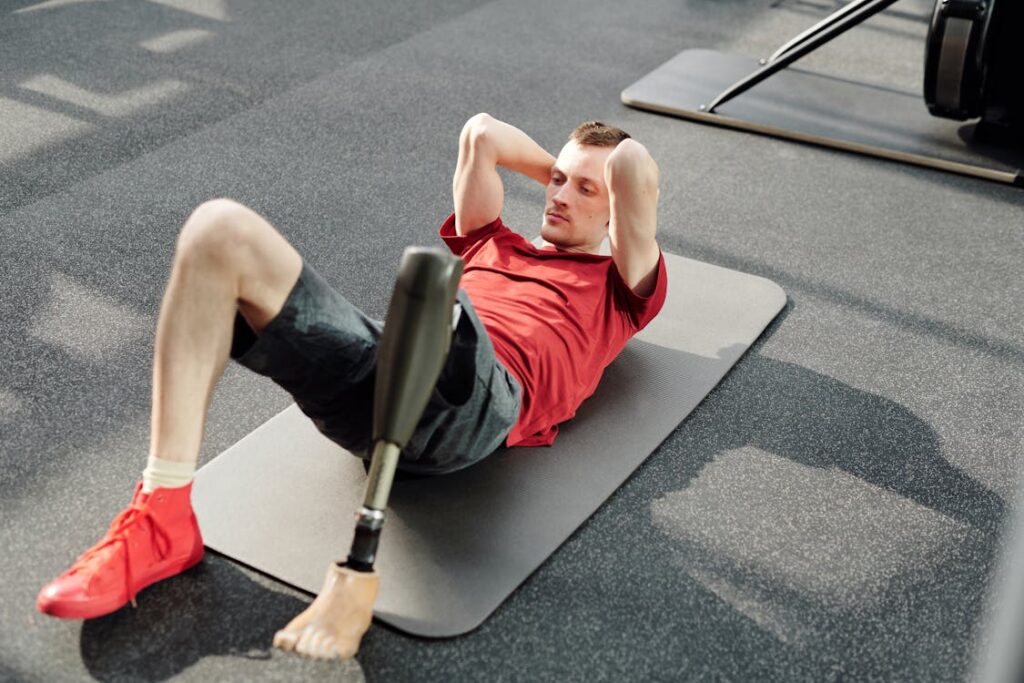
Exercises to Prevent Muscle Loss After Amputation
Staying active is one of the most effective ways to maintain muscle mass after an amputation. Regular movement helps prevent muscle atrophy, strengthens the body, and improves balance, which is essential for prosthetic use.
The right exercises target both the residual limb and the rest of the body, ensuring that all muscles remain engaged and functional.
Even for those who are not using a prosthetic limb yet, engaging in physical activity as early as possible can help prevent further muscle loss and prepare the body for future mobility.
Strength Training for Muscle Preservation
Strength training is crucial for maintaining muscle mass and preventing weakness. After an amputation, certain muscle groups may become overworked while others weaken due to changes in movement patterns.
Targeted strength training exercises help create a balance, ensuring that the muscles supporting the residual limb and prosthetic function remain strong.
For lower-limb amputees, focusing on strengthening the hips, core, and remaining leg is essential. Exercises such as seated leg lifts, glute bridges, and resistance band movements help maintain strength in the muscles responsible for stability and mobility.
Engaging the core through exercises like seated torso twists or gentle abdominal contractions improves balance and reduces strain on the lower back.
Upper-limb amputees benefit from strength training exercises that focus on the shoulders, chest, and back to maintain posture and prevent imbalances.
Simple resistance exercises using light weights or resistance bands help keep these muscles active. Seated shoulder presses, lateral raises, and rowing movements improve upper body strength, making daily activities and prosthetic use easier.
Weight-Bearing Activities for Bone and Muscle Strength
For those who use a prosthetic limb, weight-bearing activities help strengthen the remaining limb and maintain bone density. Walking, even for short distances, engages multiple muscle groups and prevents atrophy.
If walking is not yet possible, standing exercises that involve shifting weight between the legs can activate muscles and prepare the body for prosthetic use.
Aquatic therapy is another effective way to engage in weight-bearing activity without putting excessive strain on the joints.
Water resistance helps strengthen muscles while providing support, making it an ideal option for amputees in the early stages of rehabilitation. Movements such as walking in water, leg raises, and core rotations help build strength and improve circulation.
For upper-limb amputees, engaging in activities that require controlled resistance, such as modified push-ups or resistance band exercises, helps maintain muscle tone and improve endurance.
Grip-strengthening exercises are also beneficial for those using myoelectric prosthetics, as they improve control and coordination.
Balance and Stability Training
Muscle loss can affect balance, making it harder to move with confidence. Strengthening the stabilizing muscles through targeted exercises improves coordination and reduces the risk of falls.
Balance training is especially important for lower-limb amputees, as prosthetic walking requires core and hip stability.
Seated balance exercises are a great starting point for those who are still adjusting to their new mobility. Engaging the core while sitting on a stability ball or shifting weight from side to side helps activate deep stabilizing muscles.
For those using a prosthetic leg, practicing standing on the prosthesis while holding onto a stable surface can help improve confidence and endurance.
Tai chi and yoga are excellent options for improving balance and preventing muscle loss. These gentle movements engage the entire body, improving flexibility, core strength, and coordination.
Many rehabilitation programs incorporate these practices as part of a long-term fitness plan for amputees.
Daily Movements That Prevent Muscle Atrophy
Simple, consistent movements throughout the day can make a big difference in preventing muscle loss. Engaging in activities such as stretching, changing positions frequently, and performing light exercises while sitting helps keep muscles active.
For those who are not yet using a prosthetic, engaging the residual limb in controlled movements prevents stiffness and helps maintain muscle tone.
For lower-limb amputees, small movements such as flexing and extending the knee or performing gentle seated leg lifts keep the muscles in the residual limb engaged.
Upper-limb amputees can maintain strength by performing shoulder rolls, arm circles, and wrist flexion exercises. These small movements ensure that muscles do not become weak due to inactivity.
Maintaining an active lifestyle is key to preventing muscle loss after amputation. Combining strength training, weight-bearing activities, balance exercises, and daily movements helps keep the body strong, supports prosthetic use, and enhances overall mobility.
By making movement a consistent part of daily life, amputees can preserve their muscle mass and enjoy greater independence.
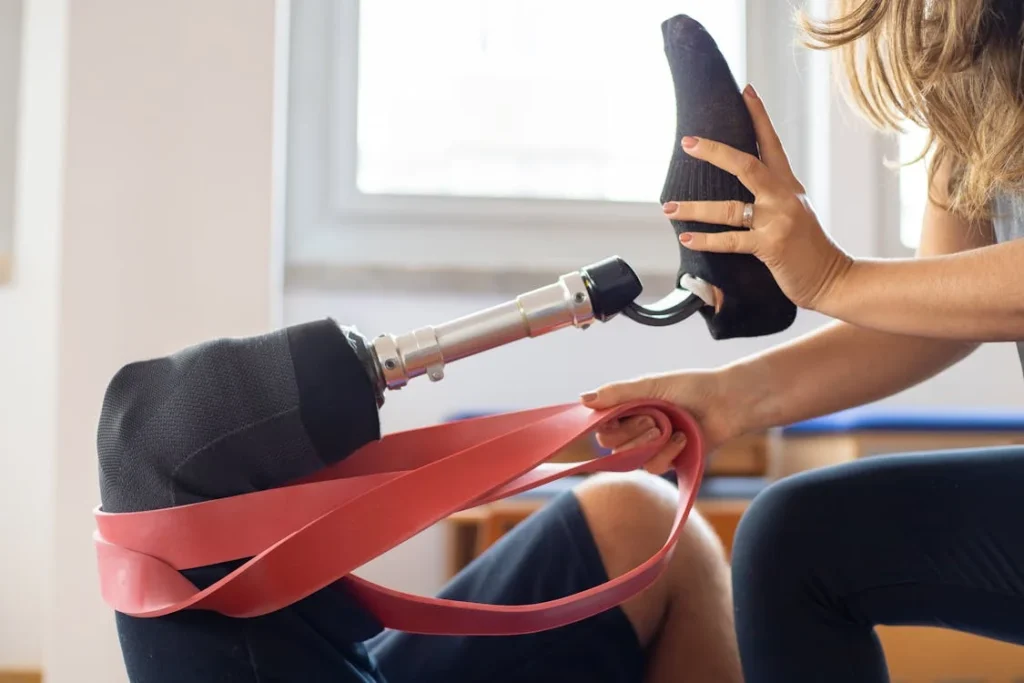
The Role of Rehabilitation and Physical Therapy in Muscle Preservation
Rehabilitation is a crucial part of preventing muscle loss after amputation. A structured rehabilitation program helps amputees regain strength, improve mobility, and prepare for prosthetic use.
Physical therapists create customized exercise plans that target the muscles most affected by amputation, ensuring that the body remains strong and balanced. Working with a professional ensures that movements are safe, effective, and tailored to each individual’s needs.
Early Rehabilitation and Muscle Activation
The sooner rehabilitation begins after an amputation, the better the chances of preventing muscle loss. In the early stages, rehabilitation focuses on gentle muscle activation to prevent stiffness and atrophy.
Even when full mobility is not yet possible, engaging the residual limb in simple movements such as stretching, flexing, and light contractions helps maintain blood flow and muscle tone.
For lower-limb amputees, early rehabilitation includes exercises to strengthen the core, hips, and intact leg. Engaging these muscles is important for future prosthetic use, as they provide the foundation for balance and movement.
Upper-limb amputees start with shoulder and back exercises to prevent posture imbalances and ensure that the remaining arm does not become overworked.
Breathing exercises are also introduced during this phase. Deep breathing helps with circulation and oxygen delivery to the muscles, reducing the risk of fatigue and promoting faster recovery.
Controlled breathing techniques also help with relaxation and stress management, both of which play a role in maintaining overall strength.
Gait Training and Prosthetic Adaptation
For lower-limb amputees, gait training is one of the most important parts of rehabilitation. Learning to walk with a prosthetic limb requires coordination, core strength, and endurance.
Without proper gait training, muscles may become imbalanced, leading to strain on the back, hips, or intact leg.
Physical therapists guide amputees through weight-shifting exercises, controlled stepping, and progressive walking drills. These exercises help develop muscle memory, ensuring that movements become more natural over time.
Using parallel bars or walkers in the early stages provides additional support while strengthening the muscles required for prosthetic walking.
Upper-limb amputees undergo similar training to adapt to prosthetic arm movements. Prosthetic control training includes exercises to improve grip strength, coordination, and range of motion.
Over time, these movements become more intuitive, making it easier to perform everyday tasks.
Balance and coordination drills are also part of this phase. Standing exercises, weight-shifting movements, and core-strengthening activities help prevent falls and improve confidence while using a prosthetic.
Many amputees who undergo regular balance training report greater comfort and ease of movement.
Advanced Strength Training and Endurance Building
As rehabilitation progresses, strength training becomes more intensive. At this stage, amputees work on building muscle endurance, increasing flexibility, and improving overall stamina.
This phase is crucial for those who want to return to an active lifestyle, whether that means walking long distances, engaging in sports, or simply performing daily activities with ease.
Lower-limb amputees focus on increasing leg strength, core stability, and hip mobility. Exercises such as resistance band work, squats, and controlled stepping drills help build endurance for prolonged prosthetic use.
Upper-limb amputees engage in resistance training for the shoulders, chest, and back, ensuring that movements remain fluid and strong.
Cardiovascular exercise is introduced to support heart health and overall fitness. Activities such as stationary cycling, swimming, and rowing provide low-impact options for improving endurance without excessive strain.
Water-based exercises, in particular, are beneficial for amputees, as they provide resistance while reducing joint impact.
Flexibility training is also emphasized during this phase. Stretching routines prevent stiffness, improve range of motion, and reduce the risk of injuries. Regular stretching helps maintain muscle elasticity, making movement feel smoother and more comfortable.
Long-Term Maintenance and Independent Exercise
Rehabilitation does not end once a prosthetic is fully integrated into daily life. Long-term muscle maintenance requires consistent exercise and movement. Developing an independent workout routine ensures that strength and mobility continue to improve over time.
Amputees who remain active through structured fitness programs, sports, or daily movement experience fewer mobility issues and reduced muscle loss.
Strength training at least two to three times per week, combined with cardiovascular activity and stretching, helps maintain muscle mass and overall health.
For those who prefer guided workouts, many rehabilitation centers offer ongoing physical therapy sessions or adaptive fitness programs. Virtual coaching, community-based exercise groups, and home-based rehabilitation programs provide additional options for staying active.
Regular check-ins with a prosthetist and physical therapist help track progress and make necessary adjustments. As fitness levels improve, exercises can be modified to provide new challenges, ensuring that muscle growth and endurance continue.
A strong rehabilitation program is the foundation for preventing muscle loss after amputation. From early muscle activation to advanced strength training, each phase of rehabilitation plays a role in maintaining mobility, improving prosthetic control, and ensuring long-term independence.
With the right approach, amputees can preserve their strength, enhance their quality of life, and confidently engage in daily activities.

Lifestyle Habits to Support Muscle Retention After Amputation
Preventing muscle loss after amputation is not just about exercise and nutrition—it requires a complete lifestyle approach. Daily habits, sleep quality, stress management, and overall movement patterns all play a role in muscle retention.
Even small adjustments in routine can significantly impact strength, endurance, and long-term mobility.
Maintaining an Active Daily Routine
One of the biggest risks for muscle loss is prolonged inactivity. When the body remains still for long periods, muscles weaken over time. While structured exercise is important, daily movement throughout the day also contributes to muscle preservation.
Simple activities such as standing up regularly, shifting positions, stretching, or taking short walks help keep muscles engaged.
For those using a prosthetic, incorporating movement into routine tasks improves endurance and balance. Instead of sitting for long hours, standing while doing simple tasks like cooking, reading, or making phone calls strengthens the core and legs.
Engaging in functional movements—such as reaching, bending, or shifting weight between the legs—ensures that the body stays active without requiring an intense workout.
Upper-limb amputees can maintain muscle function by using the residual limb in everyday activities whenever possible. Even small movements, such as holding objects, performing wrist rotations, or engaging in light resistance exercises, help keep the muscles in use.
If a prosthetic arm is being used, practicing fine motor tasks with it strengthens the muscles responsible for coordination and control.
The Importance of Quality Sleep for Muscle Repair
Sleep is when the body repairs and rebuilds muscle tissue. Poor sleep quality can slow down recovery, weaken muscles, and contribute to fatigue.
Amputees who experience discomfort, phantom limb pain, or difficulty finding a comfortable sleeping position may struggle with getting deep, restorative sleep.
Creating a sleep-friendly environment helps improve muscle recovery. A firm, supportive mattress and proper pillow positioning reduce strain on the body.
Stretching or engaging in relaxation techniques before bed helps release muscle tension. Magnesium supplementation may also help improve sleep quality by relaxing muscles and calming the nervous system.
Maintaining a consistent sleep schedule allows the body to regulate hormones responsible for muscle growth and repair. Irregular sleep patterns can increase stress hormones like cortisol, which contribute to muscle breakdown over time.
Prioritizing 7–9 hours of sleep per night ensures that the body has enough time to recover and maintain strength.
Managing Stress to Prevent Muscle Loss
Stress has a direct impact on muscle health. Chronic stress raises cortisol levels, which can lead to muscle breakdown, increased inflammation, and reduced energy levels. Managing stress effectively helps protect muscle tissue and supports overall well-being.
Deep breathing exercises, meditation, and mindfulness techniques help regulate stress and keep cortisol levels balanced. Engaging in enjoyable activities, socializing with friends, or participating in hobbies provides mental relaxation and keeps motivation levels high.
Regular movement itself is a stress reliever. Exercise releases endorphins, which help improve mood and reduce anxiety. For those dealing with stress related to mobility challenges, working with a physical therapist or joining support groups can provide encouragement and practical solutions.
Avoiding Muscle-Wasting Triggers
Certain habits accelerate muscle loss and should be minimized. Smoking restricts blood flow to the muscles, reducing their ability to recover and grow.
Excess alcohol consumption interferes with muscle repair and depletes the body of essential nutrients. A diet high in processed foods and refined sugars contributes to inflammation, making it harder for muscles to function optimally.
Skipping meals or not eating enough protein leads to muscle breakdown. The body requires a steady supply of amino acids from protein to maintain muscle mass.
Consistently consuming high-quality protein sources throughout the day prevents the body from using muscle tissue for energy.
Prolonged bed rest or avoiding physical activity due to fear of injury can also lead to muscle loss. While caution is necessary, controlled and gradual movement is always better than complete inactivity. Even seated exercises or light stretching can prevent rapid muscle decline.
Long-Term Commitment to Muscle Preservation
Maintaining muscle strength after amputation is a lifelong process. It requires a combination of physical activity, proper nutrition, stress management, and mindful daily habits.
Staying engaged in movement, whether through structured workouts or simple daily activities, keeps muscles strong and functional.
Regular check-ups with a physical therapist or prosthetist help track progress and address any muscle imbalances or changes in mobility. Adjustments to prosthetics, exercise routines, and diet should be made as needed to ensure continued muscle maintenance.
Muscle loss is preventable with the right approach. By staying consistent with movement, fueling the body with the right nutrients, and prioritizing recovery, amputees can maintain their strength, improve mobility, and enjoy an active and independent life.
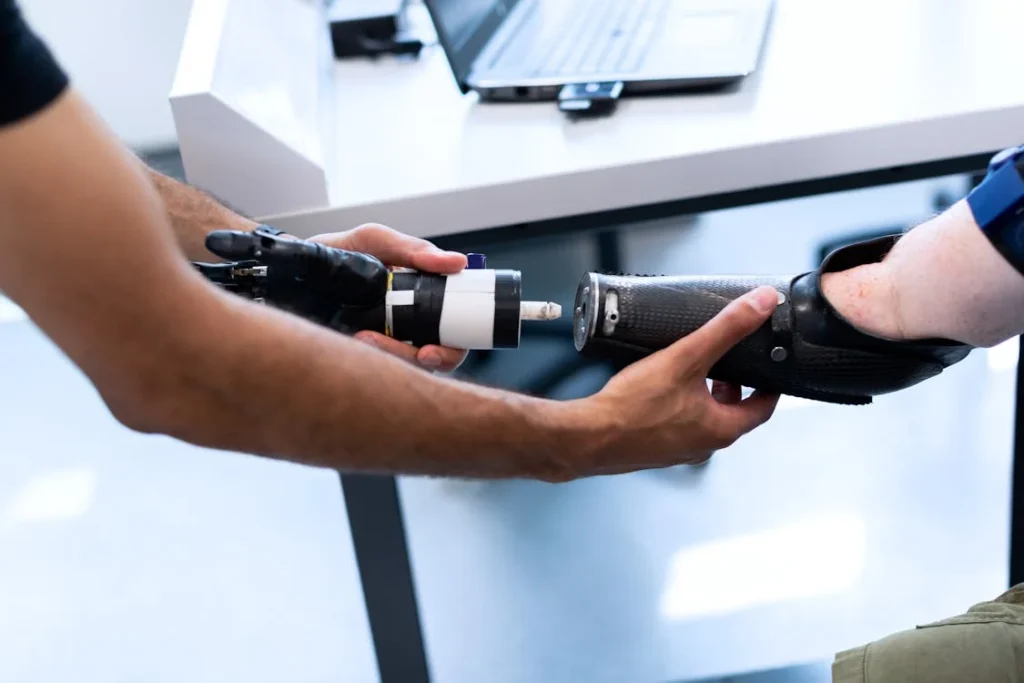
The Impact of Prosthetic Use on Muscle Retention
Wearing and using a prosthetic limb influences muscle strength, balance, and endurance. While a prosthetic allows for greater mobility and independence, it also changes how muscles are engaged.
Proper use of a prosthetic limb ensures that muscles stay active and strong, while poor prosthetic habits can lead to imbalances, muscle weakness, and even long-term joint strain.
Understanding how to use a prosthetic effectively can help amputees prevent unnecessary muscle loss and maintain better physical function.
How Prosthetic Use Affects Muscle Engagement
When a prosthetic limb is introduced, the body must adjust to a new way of moving. For lower-limb amputees, walking with a prosthetic shifts the workload to different muscle groups.
Instead of relying on natural joint movement, the residual limb, core, and hips must work harder to maintain stability. If the prosthetic is not properly fitted or used correctly, some muscles may weaken while others become overused.
For upper-limb amputees, prosthetic function depends on shoulder and back muscles. If the prosthetic is not worn regularly or not used for tasks that require strength, the muscles in the affected side may atrophy.
Over-reliance on the remaining limb can also create muscle imbalances, leading to strain and discomfort over time.
Ensuring Proper Prosthetic Fit to Maintain Muscle Strength
A poorly fitting prosthetic can contribute to muscle loss. If a socket is too loose, it does not provide the necessary stability, leading to excessive compensatory movements that strain other muscle groups.
If it is too tight, circulation may be restricted, affecting muscle function and comfort. Regular prosthetic adjustments help ensure that the residual limb is properly supported, allowing muscles to engage naturally.
For lower-limb prosthetic users, an improperly aligned prosthetic may cause an uneven gait, forcing the remaining leg and lower back to work harder than necessary.
This imbalance can lead to muscle fatigue and atrophy in underused areas. Working with a prosthetist to achieve a proper alignment ensures that muscles are engaged evenly, reducing unnecessary strain.
Upper-limb prosthetic users should ensure that their prosthetic is adjusted to allow for natural shoulder and arm movement. If a prosthetic feels awkward or difficult to control, some individuals may avoid using it, leading to further muscle loss.
Occupational therapy can help users integrate their prosthetic into daily tasks, ensuring that muscles stay active and engaged.
Active Prosthetic Use to Prevent Muscle Weakness
Merely wearing a prosthetic is not enough to prevent muscle loss—it must be actively used. Lower-limb prosthetic users should focus on proper gait mechanics, ensuring that each step fully engages the muscles in the residual limb, core, and hips.
Engaging in weight-bearing activities, such as standing exercises and controlled walking drills, helps reinforce muscle memory and strength.
For upper-limb prosthetic users, performing small, controlled movements with the prosthetic ensures that muscles in the shoulder and upper back remain active.
Incorporating prosthetic use into daily activities, such as lifting, reaching, and gripping, prevents the muscles from weakening over time. Strengthening exercises, such as resistance band training, can also improve endurance and control.
Prosthetic Training for Long-Term Muscle Maintenance
Physical therapy and prosthetic training are essential for maintaining muscle strength. Learning how to distribute weight properly, engage stabilizing muscles, and avoid overcompensation ensures that all muscles are used efficiently.
Practicing controlled, deliberate movements with a prosthetic limb builds endurance and prevents unnecessary strain on other parts of the body.
Advanced training techniques, such as using uneven surfaces or performing functional exercises with the prosthetic, help improve balance and coordination.
Adaptive sports and recreational activities also provide excellent ways to engage muscles while making movement enjoyable.
Proper prosthetic use is key to preserving muscle strength and mobility. Ensuring a good prosthetic fit, staying active, and engaging in rehabilitation exercises all contribute to long-term muscle retention.
By using the prosthetic effectively and incorporating it into daily life, amputees can maintain their strength, improve their endurance, and enjoy greater independence.
Conclusion
Preventing muscle loss after amputation requires a combination of proper nutrition, regular exercise, and effective prosthetic use. Strength training, balance exercises, and daily movement keep muscles active, while a protein-rich diet, hydration, and essential vitamins support muscle repair and endurance. Physical therapy and prosthetic training ensure that movement remains balanced, preventing overcompensation and strain on other muscles.
Maintaining an active lifestyle and making small, consistent adjustments to daily habits help preserve strength and mobility. Quality sleep, stress management, and avoiding prolonged inactivity further prevent muscle atrophy, ensuring long-term independence and ease of movement.
With the right approach, muscle loss can be minimized, allowing amputees to regain strength, improve prosthetic control, and maintain a fulfilling, active life. Prioritizing movement, nutrition, and rehabilitation creates a strong foundation for lasting mobility and confidence.



